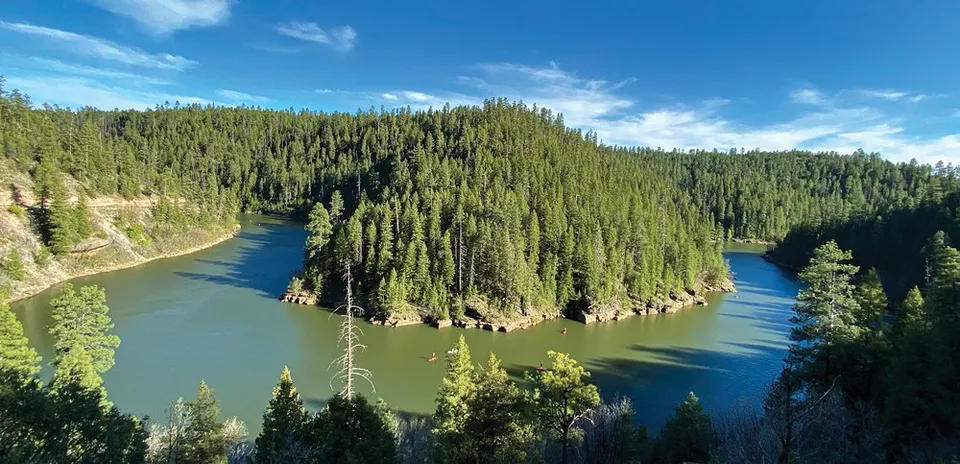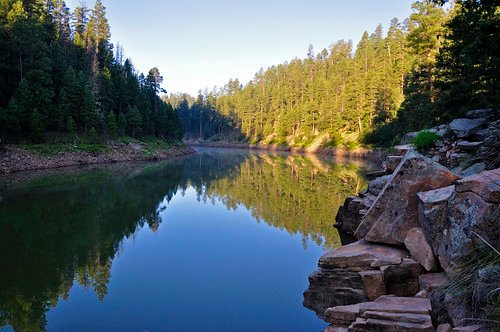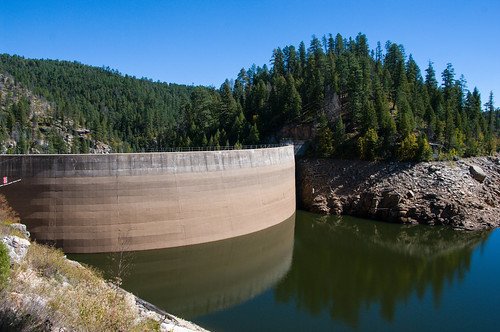
Exploring Blue Ridge Reservoir: Arizona’s Hidden Mountain Gem
Introduction to Blue Ridge Reservoir
Where is Blue Ridge Reservoir Located?
Blue Ridge Reservoir, officially known as C.C. Cragin Reservoir, is a secluded high-country lake nestled within the Coconino National Forest in north-central Arizona. Located approximately 30 miles northeast of the small town of Strawberry and around 45 miles southeast of the well-known city of Flagstaff, this pristine waterbody offers visitors a tranquil escape into Arizona’s mountainous wilderness. Positioned at an elevation of nearly 6,700 feet, the reservoir is embraced by dense forests of Ponderosa pines and rugged terrain, making it a perfect destination for anyone looking to unwind, reconnect with nature, or engage in quiet outdoor recreation far from the crowds that frequent Arizona’s more popular tourist sites.
A Snapshot of Its Natural Beauty
What makes Blue Ridge Reservoir truly stand out is its mesmerizing, narrow shape that winds like a canyon stream through the forested highlands. Unlike wide, sprawling lakes, this reservoir hugs steep cliffs and pine-draped slopes, creating a serene corridor of water that mirrors the towering trees and blue sky above. The ambiance here is profoundly peaceful, interrupted only by the soft lap of water against a kayak or the distant call of an eagle. In early morning or late evening, the surface of the reservoir becomes a glassy reflection pool, offering some of the most breathtaking natural scenes in Arizona. It’s no exaggeration to say that Blue Ridge is a slice of paradise for those in search of stillness and scenic beauty.

History and Background
How the Reservoir Was Created
Blue Ridge Reservoir was formed in the 1960s when a dam was constructed across East Clear Creek. This engineering project was designed to create a water storage system to supply Payson and other communities in the region. Originally named Blue Ridge Reservoir, it was later renamed to honor C.C. Cragin, a Salt River Project executive who played a key role in the region’s water infrastructure. The reservoir represents a union of human ingenuity and environmental stewardship, providing a critical water supply while blending almost seamlessly into the natural landscape. The creation of the dam also introduced new recreational opportunities, attracting outdoor enthusiasts who appreciate the balance of functionality and natural charm.
Its Role in Water Management
While Blue Ridge may look like a peaceful recreational lake, it plays a significant role in Arizona’s water management strategy. Operated by the Salt River Project, the reservoir provides drinking water to the town of Payson and surrounding areas. It forms part of a complex network of water sources that serve to buffer the region against droughts and seasonal water shortages. The dam helps regulate flow into East Clear Creek, ensuring consistent downstream water availability. This dual-purpose functionality — utility and recreation — has made the reservoir a vital asset to both the local environment and the communities that depend on it. Importantly, its management practices are designed to ensure minimal ecological disruption while meeting growing urban demands.
How to Get There
Driving Directions from Flagstaff and Phoenix
Reaching Blue Ridge Reservoir requires a bit of a drive, but that’s part of the adventure. From Phoenix, it’s about a 2.5-hour journey north via Highway 87, also known as the Beeline Highway. You’ll pass through scenic mountain towns like Payson, then take Forest Road 751 near Clint’s Well, which leads directly to the reservoir. From Flagstaff, the drive is shorter — approximately 1.5 hours southeast through dense pine forests and across the dramatic Mogollon Rim. Though the forest roads leading to the reservoir are mostly unpaved, they are passable with a standard vehicle in dry conditions. However, a high-clearance or all-wheel-drive vehicle is a safer choice, especially if you’re hauling gear or visiting after rainfall.

Accessibility Tips and Seasonal Road Conditions
One of the things to keep in mind is that access to Blue Ridge Reservoir can be seasonal. In winter and early spring, the forest roads may be closed due to snow or muddy conditions, making the reservoir inaccessible by vehicle. Summer and early fall are typically the best times to visit, when the roads are dry and clear. Always check with the Coconino National Forest Ranger District before your trip for the latest road conditions and possible closures. It’s also wise to download offline maps and bring a GPS device since cell reception in the area is unreliable. The isolation that gives this place its charm also means you need to come well-prepared.
Best Time to Visit Blue Ridge Reservoir
Weather Patterns
Thanks to its high elevation, Blue Ridge Reservoir enjoys a climate that’s refreshingly cool compared to the desert basins of Arizona. Summers here are pleasantly mild, with daytime highs averaging between 75°F and 85°F. Nights can be crisp, often dipping into the 40s. In winter, snow blankets the surrounding forest, creating a magical, though less accessible, landscape. Spring brings blooming wildflowers and new greenery, while autumn offers a spectacular display of golden aspens and fiery maples. This range of seasonal beauty makes Blue Ridge a year-round gem — though access is best from late May through October.
Seasonal Activities
Each season offers something special. In summer, the lake becomes a haven for kayaking, fishing, and swimming, with its clear, cold water offering a welcome escape from the heat. Spring is ideal for wildlife viewing and photography, as the forest awakens with color and activity. Fall is perfect for hiking and reflective paddling through vibrant foliage. Winter, although stunningly beautiful with snow-covered trees and frozen water edges, is not recommended for casual visitors due to road closures and extreme cold. For the ultimate Blue Ridge experience, aim for late summer or early fall — the sweet spot for both weather and access.
Recreational Activities at Blue Ridge Reservoir
Kayaking and Canoeing Adventures
If there’s one thing you absolutely must do at Blue Ridge Reservoir, it’s kayaking or canoeing. The reservoir’s narrow, winding shape makes for an exciting paddle through towering pine forests and sandstone cliffs. With calm waters and minimal boat traffic — especially on weekdays — paddlers can explore hidden coves and scenic inlets that feel completely untouched by time. Imagine gliding silently across the mirror-like surface, watching dragonflies skim the water while a hawk soars overhead. Whether you’re a beginner or seasoned paddler, the experience is nothing short of meditative. Don’t forget your dry bag and camera — you’ll want to capture the magic.

Fishing in the Reservoir
Fishing is another beloved pastime here. Blue Ridge Reservoir is stocked with rainbow trout and occasionally brown trout by the Arizona Game and Fish Department. The cool, oxygen-rich waters support a healthy fish population, making it a favorite spot for both fly fishers and bait anglers. Early mornings and late evenings are prime times to cast your line, especially in summer when the fish are more active. Be sure to bring your Arizona fishing license and check current regulations, as seasonal limits and catch rules can vary. Whether you’re fishing from the shoreline or a kayak, the peaceful atmosphere adds to the thrill of the catch.
Hiking Trails Around Blue Ridge Reservoir
Best Nearby Trails for All Skill Levels
While Blue Ridge Reservoir itself doesn’t have a formal trail system, nearby forest service roads and unmarked paths offer a variety of hiking opportunities. The general area is part of the Mogollon Rim, known for its breathtaking views and network of trails. One local favorite is the General Crook Trail, which follows historic routes used during military expeditions. For something more relaxing, consider short forest walks along the reservoir’s edge — you’ll be rewarded with sweeping views and the occasional wildlife sighting. Always wear proper hiking boots and carry water, as the forest can be deceptively rugged, even on seemingly easy paths.
Wildlife and Nature Watching
Animals Commonly Seen
Blue Ridge is teeming with wildlife, thanks to its remote location and diverse ecosystems. You might spot elk grazing near the water at dawn, or deer darting through the forest. Birdwatchers can catch glimpses of bald eagles, ospreys, and red-tailed hawks. In quieter spots, beavers are known to construct small dams, and otters sometimes play near the shoreline. If you’re lucky (and quiet), you may even hear the distant howl of a coyote or spot bobcat tracks in the mud. Always maintain a respectful distance and avoid feeding animals — preserving the wild experience benefits everyone.
Flora and Foliage
The flora here is just as stunning. Towering Ponderosa pines dominate the landscape, their vanilla-scented bark a signature feature of the forest. You’ll also encounter Gambel oaks, Douglas firs, and colorful wildflowers in spring and summer. Come fall, aspens blaze in brilliant yellow, contrasting beautifully against the evergreens. The reservoir’s shoreline features willows and alders, and if you’re observant, you might find edible berries or wild mushrooms (though only forage if you’re experienced). The ever-changing tapestry of plant life ensures every visit feels fresh and new.
Camping Near Blue Ridge Reservoir
Best Campgrounds and Dispersed Camping Spots
Camping near Blue Ridge Reservoir is a favorite way to fully immerse yourself in its serene surroundings. While there are no developed campgrounds right on the reservoir, Rock Crossing Campground is a popular choice just a few miles away. It offers basic amenities like picnic tables, fire rings, and vault toilets. For those who prefer solitude, dispersed camping is permitted throughout the surrounding national forest — just be sure to follow Leave No Trace principles. Set up your tent beneath the pines, cook over an open fire, and fall asleep to the sound of wind rustling through the trees. It doesn’t get more peaceful than that.
Boating Information and Restrictions
What Types of Boats Are Allowed?
Blue Ridge Reservoir allows small watercraft such as kayaks, canoes, and small motorboats (limited to 10 horsepower). Because the reservoir is narrow and winding, it’s not well-suited for large boats or high-speed boating. This restriction helps preserve the tranquil environment and ensures safety for paddlers and anglers. Electric trolling motors are also allowed, which are great for a quiet fishing trip. There’s a single boat ramp near the dam, but space is limited — arrive early to get a spot, especially on weekends.
Photography and Scenic Spots
Top Photo Locations
Photographers, rejoice! Blue Ridge Reservoir offers an abundance of scenic spots that are Instagram-worthy without needing a filter. The best photo ops include sunrise reflections on the water, mist rising through the pine trees, and the golden hues of fall foliage mirrored in the lake. If you’re into astrophotography, the clear night skies here — unpolluted by city lights — make for stunning starry landscapes. Bring a tripod, a wide-angle lens, and plan a golden hour hike along the ridge for those breathtaking shots you’ll want to frame.
Safety Tips and Things to Bring
Must-Haves for Your Visit
The reservoir’s remoteness means you should pack carefully. Bring plenty of water, sun protection, a first aid kit, bug spray, and layers for unpredictable weather. Navigation tools are a must — think GPS, a map, and a compass — as cell signals are spotty at best. If you’re boating or kayaking, don’t forget life vests and safety whistles. Those camping should pack extra food and emergency supplies. It’s better to be overprepared than caught off guard. Always let someone know your plans and expected return time, especially if you’re venturing alone.
Rules and Regulations
Forest Service Guidelines
As part of Coconino National Forest, Blue Ridge Reservoir is subject to federal rules aimed at conservation. Campfires may be restricted during dry months due to wildfire risk, and all trash must be packed out. Dogs are allowed but should be kept under control. Fishing regulations change seasonally, so check with Arizona Game & Fish before casting your line. Rangers occasionally patrol the area — not to hassle visitors, but to ensure safety and preserve the site for future generations.
Hidden Gems and Local Secrets
Lesser-Known Areas to Explore
Beyond the main launch ramp, there are secret spots around the reservoir worth discovering. Small trails branch off into secluded coves, some ideal for a private picnic or peaceful fishing session. Local kayakers often recommend paddling all the way to the far end of the lake where the water narrows into a canyon — it’s like finding your own private wilderness. Keep your eyes peeled for little rock outcroppings and meadows hidden behind the trees. These spots often reveal the true magic of Blue Ridge.
Conclusion
Blue Ridge Reservoir is one of Arizona’s best-kept secrets — a mountain sanctuary that combines natural beauty, outdoor adventure, and peaceful seclusion. Whether you’re fishing at dawn, paddling through mirror-like waters, or simply soaking up the silence of the pines, every moment spent here feels like a small escape from the chaos of modern life. It’s not just a destination — it’s an experience that resets your soul and rekindles your appreciation for the wild. So pack up your gear, grab your camera, and take the scenic route to Blue Ridge. Trust me, it’s worth every mile.
FAQs
1. Do I need a permit to kayak or fish at Blue Ridge Reservoir?
Yes, you’ll need a valid Arizona fishing license to fish. No permit is required for kayaking, but safety gear like life vests is strongly advised.
2. Can I swim in Blue Ridge Reservoir?
Yes, swimming is allowed, though there are no designated swim beaches. The water can be very cold even in summer, so swim with caution.
3. Is Blue Ridge Reservoir family-friendly?
Absolutely. It’s great for family outings, but the remote setting means you should come well-prepared with supplies and safety gear.
4. Are dogs allowed at the reservoir?
Yes, pets are welcome, but they should be kept under control and cleaned up after. A leash is recommended, especially near the water.
5. When is the best time of year to visit?
Late spring through early fall is ideal. Summer offers the most activities, while fall brings colorful foliage and fewer crowds.

Leave a Reply